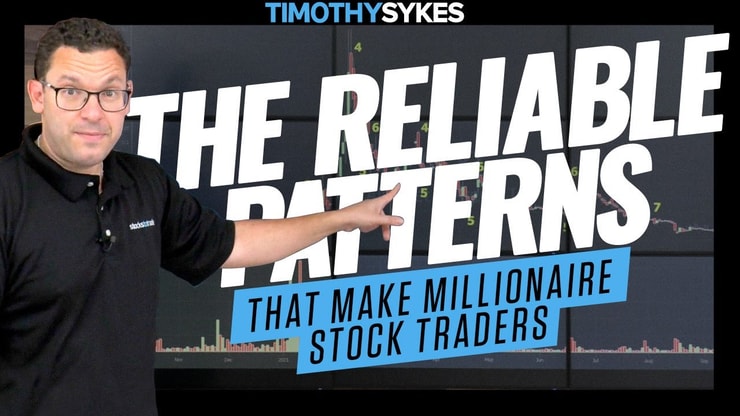Marubozu candlesticks are candlestick patterns that only extend in one direction — with no upper wicks or lower shadows. They indicate strong buying or selling pressure throughout the day, either closing at a low or high price.
One of the first changes new traders make is the switch from line charts to candlestick charts.
At first, candlesticks might look a little confusing.
But with a little experience, reading them becomes second nature.
We use candlesticks because the charts show us more data than a line chart. That way we can identify patterns more effectively.
I’ve been trading for over 20 years and I don’t think I’ve ever used a line chart. It’s just a reality of the industry.
To stay competitive in this niche, we’ve got to digest data that the average trader doesn’t or won’t.
The average trader is gambling off hot picks with a line chart.
Understanding the Marubozu candlestick gives you an upper hand.
Here’s everything you need to know …
Table of Contents
- 1 What Is a Marubozu Candlestick?
- 2 Characteristics of Marubozu Candlestick
- 3 How To Identify Marubozu Candlestick Patterns
- 4 Trading With Marubozu Candlestick
- 5 Key Takeaways
- 6 Frequently Asked Questions (FAQs)
- 6.1 What Is a Marubozu Candlestick?
- 6.2 How Do You Trade a Marubozu Candlestick Pattern?
- 6.3 Can a Marubozu Candlestick Pattern Predict Trend Direction?
- 6.4 What Are Marubozu Candlesticks, and How Do They Relate to Support and Resistance Levels in Chart Patterns?
- 6.5 How Can Forex Traders Utilize Stop Loss Strategies and Investment Advice To Minimize Losses in the Markets?
- 6.6 What Resources, Such As Blogs, Trials, and Tips, Are Available on Your Site for Clients and Members Looking To Learn About Marubozu Candlesticks?
- 6.7 How Can Investors Calculate the Number of Losses, Amount Invested, and Adjust Their Trading Strategies Accordingly?
- 6.8 How Can Traders Recognize Doji and Hammer Patterns, and What Support Levels and Types of Signs Should They Look For?
What Is a Marubozu Candlestick?

2025 Millionaire Media, LLCThe Marubozu candlestick is a simple yet powerful sign in technical analysis. It’s one of the Japanese candlestick chart patterns that lack wicks or shadows.
The body, representing the opening and closing price, forms the entirety of the candle. In this pattern, the open and close, or high and low, are identical, symbolizing control by either buyers or sellers throughout the trading session.
In understanding the Marubozu candlestick, you’re not just looking at an image; you’re interpreting a movement in the market.
Just like with all of my trading patterns …
This candlestick reveals strong sentiment among bulls or bears and is often considered a continuation pattern. The tools, services, and documents provided by brokers and trading platforms often include information about Marubozu, highlighting its importance in the trading world.
Understanding the Marubozu candlestick is just the beginning of your journey into the world of candlestick patterns. Another intriguing pattern to explore is the shooting star candle.
This pattern often appears at the top of an uptrend and can signal a potential reversal. Recognizing the shooting star candle in conjunction with the Marubozu can provide a more nuanced understanding of market trends.
If you’re interested in expanding your knowledge, you can learn more about the Shooting Star Candle Pattern and how to trade it effectively.
Characteristics of Marubozu Candlestick
The Marubozu candlestick’s appearance can vary, with bullish and bearish forms offering unique insights. Its characteristics provide clues about market sentiment, trend direction, and potential opportunities for traders.
But it’s only effective if the data we’re using is up to date.
Most chart software displays data 10-20 minutes late. No matter how strong the Marubozu candlestick formation is, late data doesn’t help me at all.
That’s why I use StocksToTrade. It has up-to-date data, the hottest indicators built in, and I helped design it specifically for small-account traders.
>> Try this 14-day trial of StocksToTrade for $7 <<
While the characteristics of the Marubozu candlestick provide valuable insights into market sentiment, it’s essential to recognize other patterns that may appear in conjunction with it.
Think of them like partners.
One such pattern is the bearish engulfing candle, which can signal a potential bearish reversal. Understanding how the bearish engulfing candle interacts with the Marubozu can enhance your trading strategies and decision-making.
For a deeper dive into this pattern and how it can be used in various trading scenarios, explore the detailed guide on the Bearish Engulfing Candle.
Characteristics of Bullish Marubozu Candle
A bullish Marubozu candle opens at its low and closes at its high. It’s a green or white candle without shadows, signaling strong control by the buyers.
The trading strategies for this pattern emphasize the opportunities for going long in stocks, forex, or other securities. Partnering with the right broker and platform, you can take advantage of this powerful bullish sign.
We often see bullish Marubozu candles during first green day patterns …
Characteristics of Bearish Marubozu Candle
On the other hand, a bearish Marubozu candle opens at its high and closes at its low. It’s usually red or black, and like its bullish counterpart, lacks wicks or shadows.
The trading environment for this pattern signals opportunities for shorting an asset. It’s essential to consult with trading experts or use the right tools and indicators to analyze this pattern.
Shorting can be a dangerous strategy. The fact is, it’s possible to lose more money than you put in. In conclusion, as a rule, I instruct new traders to focus on long positions.
More Breaking News
- BTBT’s Ethereum Strategy Sparks Investor Interest
- EHGO’s Unexpected Surge: What to Know
- Cogent Biosciences’ Bold Move: Can It Boost Stock?
Marubozu at the Kickoff of a New Trend
The Marubozu candlestick can be a crucial signal at the start of a new trend. Whether bullish or bearish, the Marubozu pattern’s strong characteristics can be a clear sign of trend reversal or continuation.
This is not just about looking at an image on a chart; it’s about leveraging years of experience, research, and trading skills to interpret what the market is saying.
Marubozu Pattern in the Middle of a Trend
When the Marubozu pattern appears in the middle of a trend, it’s a strong confirmation of the trend’s direction.
Both individual traders and trading companies should recognize this as a continuation pattern. It offers a clear point to make trading decisions based on solid technical analysis.
Why a Blow-Off Top May House a Marubozu Pattern
In certain cases, a Marubozu pattern may appear at a blow-off top, signaling a potential reversal in an uptrend.
This pattern might be accompanied by high volume, and interpreting it correctly requires careful analysis. The market’s reaction here is more than just a change in price action; it’s a shift in control from buyers to sellers.
How To Identify Marubozu Candlestick Patterns

2025 Millionaire Media, LLCIdentifying Marubozu candlestick patterns involves more than just recognizing a candle without wicks. It’s about understanding the opening, closing, high, and low prices, and how they reflect market sentiment.
The absence of wicks in a Marubozu candle is a strong sign of one side’s control, whether it’s the buyers or sellers.
Utilizing tools like RSI, MACD, or moving averages provided by your trading platform or broker can enhance the identification process. Trading with Marubozu requires a combination of technical analysis and keen insights into market movements.
The services and information provided by financial experts or reviews from experienced traders can guide you in using the Marubozu candlestick effectively.
Check out my guide to the 20 candlestick patterns you need to know — with examples!
Trading With Marubozu Candlestick
The Marubozu candlestick isn’t just a pattern on the chart; it’s a robust trading strategy when interpreted correctly.
Whether trading in the stock market, forex, or other financial instruments, the Marubozu pattern can guide both entry and exit points.
I mainly trade small-cap stocks. The low share supply adds to the volatility. And the low price ensures I can load up on shares.
It’s not gambling, there’s a specific trading process I use every single time.
I show it to all my students in the Challenge. If you like this industry and you think you have what it takes …
>> Apply for the Trading Challenge <<
I already have over 30 millionaire students. They all started here.
Trading with the Marubozu candlestick pattern offers various opportunities for both bullish and bearish trades. However, for the best trading products, it’s beneficial to understand other related patterns in the company of the Marubozu candle.
One such pattern is the candlestick reversal pattern, which can provide additional insights into potential market reversals. By incorporating the knowledge of candlestick reversal patterns with the Marubozu, you can enhance your trading strategies and make more informed decisions.
If you’re looking to broaden your understanding of these patterns, check out the comprehensive article on Candlestick Reversal Patterns.
Trading Bullish Marubozu Candlestick Pattern
Trading with a bullish Marubozu candle involves recognizing strong buying pressure. It’s not just about following a trend; it’s about understanding the bullish sentiment and the continuation opportunities that might arise.
Utilizing a well-researched trading strategy, you can position yourself to benefit from the upward movement.
Trading Bearish Marubozu Candlestick Pattern
A bearish Marubozu candle, and vice versa, represents strong selling pressure. The trading strategies for this pattern should recognize the bearish control and potential downtrend continuation or reversal.
Consult with your broker, use reliable trading tools, and always consider risk management to capitalize on this pattern.
How To Use Marubozu Candlestick Pattern To Predict the Trend Direction
Using the Marubozu candlestick pattern to predict trend direction requires more than understanding its formation; it’s about leveraging years of experience and sound technical analysis.
Recognizing the bullish or bearish control in a Marubozu candle offers clues to trend continuation or reversal. The insights provided by experts, trading platforms, and market analysis documents can guide your decisions.
Key Takeaways

2025 Millionaire Media, LLCThe Marubozu candlestick pattern is a powerful tool for understanding market sentiment and making informed trading decisions.
Recognizing the bullish and bearish characteristics of this pattern and how it appears in various stages of a trend can lead to profitable opportunities.
In addition to understanding the Marubozu pattern itself, successful trading with it requires a combination of technical analysis, risk management, and the right choice of broker and platform.
Whether you’re trading stocks, forex, or other securities, the Marubozu pattern can guide your decisions in a dynamic market environment.
It isn’t a silver bullet for your trading plan — but the Marubozu candlestick pattern is one of many topics you should learn as part of your trading education!
Trading isn’t rocket science. It’s a skill you build and work on like any other. Trading has changed my life, and I think this way of life should be open to more people…
I’ve built my Trading Challenge to pass on the things I had to learn for myself. It’s the kind of community that I wish I had when I was starting out.
We don’t accept everyone. If you’re up for the challenge — I want to hear from you.
Apply to the Trading Challenge here.
Trading is a battlefield. The more knowledge you have, the better prepared you’ll be.
Do you use the Marubozu candlestick pattern in your trading strategy? Let me know in the comments — I love hearing from my readers!
Frequently Asked Questions (FAQs)
Understanding the Marubozu candlestick pattern isn’t just about recognizing its appearance; it’s about leveraging this knowledge for successful trading.
Here are some common questions about this pattern.
What Is a Marubozu Candlestick?
A Marubozu candlestick is a Japanese candlestick pattern that lacks wicks or shadows. The body section represents the entire candle, symbolizing strong control by either buyers or sellers throughout the trading session.
Since the creation of candlestick patterns, they’ve grown in popularity world wide. One of their uses in the United States is for stock charts.
But every trader is different like every person is different. Whether or not others use this pattern is up to them and their trade strategy.
How Do You Trade a Marubozu Candlestick Pattern?
Trading with the Marubozu candlestick pattern involves recognizing its bullish or bearish characteristics and leveraging this information for entry and exit decisions.
Whether trading in stocks, forex, or other financial instruments, utilizing technical analysis and risk management, with the support of a trusted broker or platform, can guide successful trades.
Can a Marubozu Candlestick Pattern Predict Trend Direction?
The Marubozu candlestick pattern can predict trend direction by signaling strong control by buyers or sellers.
Recognizing its appearance in various stages of a trend offers valuable insights into continuation or reversal opportunities.
What Are Marubozu Candlesticks, and How Do They Relate to Support and Resistance Levels in Chart Patterns?
Marubozu candlesticks are a specific type of candlestick pattern with no wicks, reflecting strong buying or selling pressure.
These candlesticks often signify critical support or resistance levels within chart patterns, indicating potential price reversals or continuations. For example, a bullish Marubozu at a support level could signal an upcoming uptrend.
How Can Forex Traders Utilize Stop Loss Strategies and Investment Advice To Minimize Losses in the Markets?
In forex trading, stop-loss strategies allow investors to set predefined levels at which positions are automatically closed, reducing potential losses.
Investment advice from seasoned professionals can further guide traders in identifying profitable opportunities and managing risk in the markets. Both techniques are essential for capital preservation and long-term success.
What Resources, Such As Blogs, Trials, and Tips, Are Available on Your Site for Clients and Members Looking To Learn About Marubozu Candlesticks?
Our site offers a variety of resources to help clients and members understand Marubozu candlesticks and other trading concepts.
These include educational blogs, free trial access to premium content, and actionable trading tips provided by expert authors. Feel free to explore the site or contact our support at the given address for more information.
How Can Investors Calculate the Number of Losses, Amount Invested, and Adjust Their Trading Strategies Accordingly?
Investors can keep track of the number of losses and the total amount invested in their trading account.
Monitoring these figures enables traders to analyze performance, adjust strategies, and make informed investment decisions. Recognizing patterns in losses may lead to the identification of key areas for improvement or the opportunity to refine risk management techniques.
How Can Traders Recognize Doji and Hammer Patterns, and What Support Levels and Types of Signs Should They Look For?
Doji and hammer are significant candlestick patterns that traders often observe to understand potential market reversals.
The doji pattern, characterized by a small or non-existent body, signifies indecision, while the hammer often signals a bullish reversal. Recognizing these patterns requires understanding the support levels where they occur.
Different sign types, like trend lines or moving averages, can aid in identifying these support levels. Examples of these patterns can be found in many trading textbooks and online resources, allowing traders to become familiar with their appearance and implications.











Leave a reply